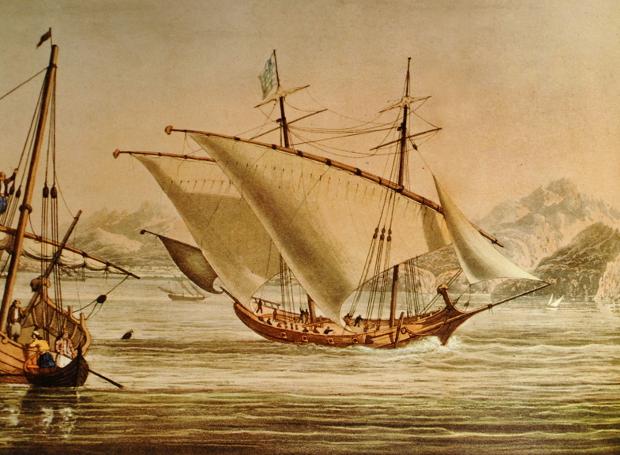|
The Galloglaich ("Galloglas") were Scottish mercenaries in Ireland, forming the backbone of the Irish armies from the late 1200s through the early 1600s. They were drawn from the best fighters in the Hebrides, mostly MacDonalds but also including the MacRorys, MacSwineys (or MacSweeneys), MacSheehys, MacDowells, and MacCabes. The word galloglaich means "foreign young warrior", and refers not only to the fact that they were from outside Ireland, but that they were of mixed Scottish-Viking stock, the result of many centuries of Viking raids on the Western Isles and Scotland's western coast.
During this time period, the Anglo-Normans (the "English" or, to us Scots, the "Sassenachs") were constantly invading Ireland, trying to take it over as they had Britain, and the Irish were having a hard time fighting them off. The English had many heavily armored, mounted knights; their charge, with lances couched, could usually break up the lightly armored Irish troops. They were also better equipped for, and more experienced with, long campaigns and large set-piece battles, where the Irish were more used to short, small-scale clan conflicts.
The Scots had experience in dealing with the mounted English knights, and the heavily armed and armored galloglaich put that experience to good use, which is why they were so valuable to the Irish. While the average Irish warrior wore only padded or leather armor, the galloglaich were well-armored with a hauberk (mail coat) and helmet. Their favored weapon was a large axe, about six feet long, variously described by foreign observers as a halberd or bardiche, but generally what we now call a sparth axe; it had a long, narrow, curved blade about 18" long, attached by its center and bottom to the pole. Other designs have also been illustrated, of course, but it was the sparth axe for which they were famous. Otherwise, they carried a sgian (knife, not unlike a ballock dagger or dirk), and as time went on they adopted various Irish-styled swords, some as large as claymores. With their axes, they could break a knight's lance, or bring down rider and horse. They were noted for their courage and fierceness in battle; they were placed in the van (lead, front and center) of the Irish armies, with the lighter armed Irish footmen and cavalry guarding their flanks. In typical Celtic fashion, they would close quickly with their opponents in a ferocious and violent attack; they would either win quickly or die in the attempt. The English quickly learned to fear the galloglaich.
The galloglaich were well-paid for their efforts. In a society that valued cattle as wealth, they received 3 cattle per quarter-year, as well as all the grain and butter they needed. A consapal (captain) was paid even more, of course, and many became quite wealthy, owning large tracts of land. They were also fairly independent, and the MacDonalds had territory in the Glens of Antrim, where they were independent of both the Irish and the English. There, they maintained a continual military presence for several centuries. They got their start in 1259, when Aed O'Connor married a MacDonald princess; she was accompanied to Ireland by 160 MacDonald warriors. In addition to the battles against the English, they took part in many clan squabbles as well, sometimes on both sides. Their prominence lasted well into the 1500s, when England started another massive push into Ireland. During this time, the galloglaich were joined by more Scottish warriors, again mostly Hebridean, and called by the English "Redshanks" (a name that had been applied by the English to the Scots for quite some time, alluding to the Scots' practice of going bare-legged and barefoot). These new warriors carried claymores, and some had firearms. This signaled a change in the styles of warfare to which the galloglaich had become accustomed; they continued to do well for a time, but by the late 1500s, they had become an anachronism. Pike formations protected by musketeers could blunt their charges, and were less vulnerable that mounted knights. Cannons and musket fire could carve through their ranks before they closed for hand-to-hand combat. They enjoyed amazing success in campaigns from 1595 through 1600, but their last appearance was at the battle of Kinsdale in 1601, where they were decimated by the English in a pitched battle.
While they were an anachronism at the end, and were ultimately defeated, the galloglaich played a huge role in preserving another part of Gaelic culture against the English for several centuries longer than might have happened without them. And by distracting the English with the Irish, they probably kept them out of the Scottish Highlands for a time, allowing that culture to survive also, and keeping our heritage richer than it otherwise might have been.
REFERENCES:
McCain, Barry Reid, 'The Galloglaich', "The Highlander", January-February 1994, Angus J. Ray Associates, Inc. Barrington, IL, USA, 1994.
Newark, Tim, Celtic Warriors, Blandford Press, Poole, Dorset, GB, 1986.
Dunbar, John Telfer, The Costume of Scotland, B. T. Batsford Ltd, London, GB, 1981.
|












